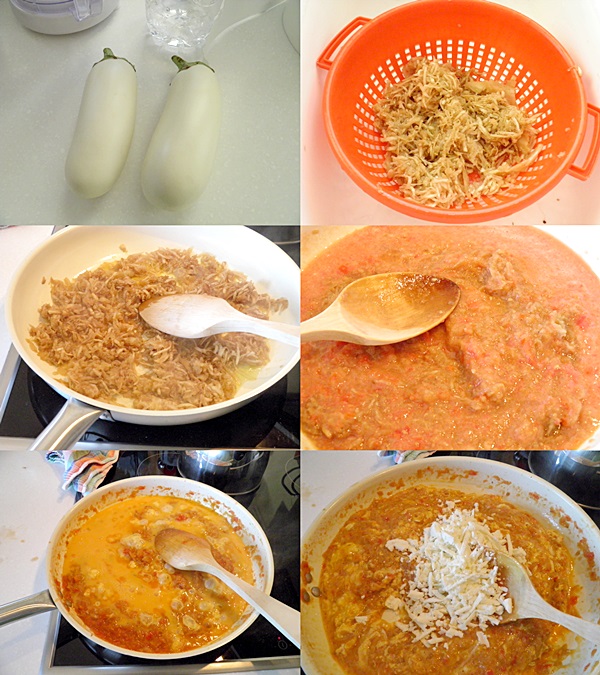Η συνταγή και στα ελληνικά στο τέλος της ανάρτησης!
Santorini is the most amazing Greek island. I will render wikipedia’s description because, although I speak quite good English, I wouldn’t be able to describe what it is as accurately as wiki.
“Santorini is essentially what remains after an enormous volcanic eruption that destroyed the earliest settlements on a formerly single island, and created the current geological caldera. A giant central, rectangular lagoon, which measures about 12 by 7 km (7.5 by 4.3 mi), is surrounded by 300 m (980 ft) high, steep cliffs on three sides. The main island slopes downward to the Aegean Sea. On the fourth side, the lagoon is separated from the sea by another much smaller island called Therasia; the lagoon is connected to the sea in two places, in the northwest and southwest. The depth of the caldera, at 400m, makes it possible for all but the largest ships to anchor anywhere in the protected bay. The capital, Fira, clings to the top of the cliff looking down on the lagoon.

It is the most active volcanic centre in the South Aegean Volcanic Arc, though what remains today is chiefly a water-filled caldera. The volcanic arc is approximately 500 km (310 mi) long and 20 to 40 km (12 to 25 mi) wide. The region first became volcanically active around 3–4 million years ago, though volcanism on Thera began around 2 million years ago.
The island is the site of one of the largest volcanic eruptions in recorded history: the Minoan eruption (sometimes called the Thera eruption), which occurred some 3,600 years ago at the height of the Minoan civilization. The eruption left a large caldera surrounded by volcanic ash deposits hundreds of metres deep and may have led indirectly to the collapse of the Minoan civilization on the island of Crete, 110 km (68 mi) to the south, through a gigantic tsunami. Another popular theory holds that the Thera eruption is the source of the legend of Atlantis.”

Because of its volcanic soil, the island’s produce has a unique flavor. It is famous for its wines, tomatinis and white eggplants. White eggplant or melitzána as we call it here is another unique product of the Santorini soil. It has very few seeds, does not absorb much oil when fried and has a particularly sweet taste. This dish is traditional and is similar to scrambled eggs, but we add also eggplant and juice from tomatinis. It is a delicious dish that can be eaten during breakfast or brunch or as a light dinner. Put it on a warm slice of bread and you will have an amazing bruschetta. I made a few changes to adapt it to our palate and we had the most amazing breakfast.
- 1 white eggplant
- 2 eggs
- 1 cup tomato juice either from Santorini tomatinis or plain tomatoes
- 1 tsbp sugar
- ¼ tsp ground nutmeg
- ¼ tsp cinnamon
- Salt and pepper
- 100 gr. Goat cheese or feta, crumbled and divided
- Couple of tbsp of olive oil for sauteeing the eggplant
- Chopped parsley for garnishing
- Peel the eggplant and grate it in the cheese grater.
- In a skillet in medium/high heat pour the olive oil and saute the eggplant for about 3 minutes.
- Pour the tomato juice, salt and pepper, sugar, nutmeg and cinnamon and boil in medium high heat until most of the water from the tomatoes is absorbed.
- Add half of the cheese and stir.
- In the meantime in a bowl whisk slightly the eggs.
- Throw the eggs and start mixing just like you do in scrambled until they are done but without letting the batter become dry.
- Remove, garnish with the rest of the cheese, the chopped parsley and serve on top of warm bread.
- 1 λευκή μελιτζάνα Σαντορίνης, τριμμένη στον τρίφτη
- 2 αυγά
- 1 φλ. τοματοχυμό είτε από τοματίνια Σαντορίνης είτε από κανονικές ντομάτες
- 1 κοφτή κουτ. σούπας ζάχαρη
- ¼ κ.γ. μοσχοκάρυδο
- ¼ κ.γ. κανέλα
- ψιλοκομμένος μαϊντανός για το σερβίρισμα
- αλάτι, πιπέρι
- 100 γρ. κατσικίσιο τυρί
- Καθαρίστε τη μελιτζάνα από τη φλούδα της και τρίψτε τη στο χοντρό τρίφτη.
- Σε ένα μεγάλο τηγάνι ρίξτε ελαιόλαδο σε μέτρια φωτιά και σωτάρετε τη μελιτζάνα για 3 λεπτά περίπου.
- Προσθέστε τον τοματοχυμό, αλάτι, πιπέρι, κανέλα, μοσχοκάρυδο, το μισό τυρί και ζάχαρη και βράστε σε δυνατή φωτιά για 3-4 λεπτά ή μέχρι να πιει η σάλτσα τα υγρά της.
- Χτυπήστε ελαφρά τα αυγά και ρίξτε τα στο τηγάνι.
- Ανακατεύετε συνεχώς μέχρι να ψηθεί το αυγό και να πήξει η στραπατσάδα, χωρίς όμως να στεγνώσει, για περίπου 2-3 λεπτά.
- Βγάλτε από τη φωτιά, ρίξτε το υπόλοιπο τυρί, λίγο μαιντανό, και σερβίρετε με ζεστό ψωμί.


